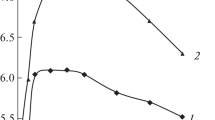Abstract.
A cationic surfactant-selective electrode for sensitive analysis of cationic surfactants has been developed by using a plasticized poly (vinyl chloride) membrane based on a hydrophobic cation exchanger, sodium tetrakis (3,5-bis(trifluoromethyl)phenyl) borate. The electrode shows a Nernstian response to dodecyltrimethylammonium (DTA) ion in the concentration range from 8 × 10−7 M to 10−2 M with a slope of 55.3 ± 2.0 mV/decade. The electrode was used over a wide pH range of pH 2–12. The electrode is excellently selective for the DTA ion over inorganic anions, but interferences of other cationic surfactants such as cetylpyridinium ion and tetradecyldimethylbenzylammonium ion (zephiramine) are great.
The present electrode was applied to determine total cationic surfactants in commercial disinfectants.
Similar content being viewed by others
Author information
Authors and Affiliations
Additional information
Received February 27, 2002; accepted June 14, 2002
Rights and permissions
About this article
Cite this article
Masadome, T. Cationic Surfactant-Selective Electrode Based on a Hydrophobic Cation Exchanger . Microchim Acta 140, 227–231 (2002). https://doi.org/10.1007/s00604-002-0916-6
Issue Date:
DOI: https://doi.org/10.1007/s00604-002-0916-6




